GOLPH3 is a potential therapeutic target and a prognostic indicator of poor survival in bladder cancer treated by cystectomy
- PMID: 26375441
- PMCID: PMC4741668
- DOI: 10.18632/oncotarget.4867
GOLPH3 is a potential therapeutic target and a prognostic indicator of poor survival in bladder cancer treated by cystectomy
Abstract
Golgi phosphoprotein 3 (GOLPH3) has been reported to be involved in the development of several human cancers. However, its clinical significance and biological role in bladder cancer remains unclear. In this study, we sought to analyze the GOLPH3 expression in bladder cancer samples and cells, and explore its clinical significance and biological role. We found that GOLPH3 was significantly increased in bladder cancer tissues and cells. Overexpression of GOLPH3 had significant correlation with poorer survival for bladder cancer patients treated by cystectomy. Knockdown of GOLPH3 inhibited the proliferation, migration and invasion of cancer cells, and tumor growth in a xenograft mouse model. GOLPH3 silencing inhibited AKT/m-TOR signaling, increased the cyclin-dependent kinase (CDK) inhibitor p27 and decreased the CDK regulator cyclin D1 and matrix metallopeptidase 9 (MMP9). Thus, GOLPH3 is likely to play important roles in bladder cancer progression via modulating AKT/mTOR signaling, and it is a novel prognostic biomarker and promising therapeutic target for bladder cancer.
Keywords: AKT/mTOR signalling; GOLPH3; bladder cancer; prognosis; survival.
Conflict of interest statement
We have no financial disclosures to declare and no conflicts of interest
Figures
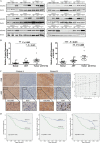
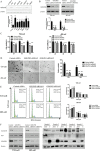
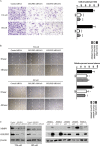

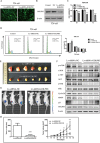
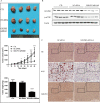
Similar articles
-
Golgi phosphoprotein 3 (GOLPH3) promotes hepatocellular carcinoma progression by activating mTOR signaling pathway.BMC Cancer. 2018 Jun 18;18(1):661. doi: 10.1186/s12885-018-4458-7. BMC Cancer. 2018. PMID: 29914442 Free PMC article.
-
Overexpression of GOLPH3 promotes proliferation and tumorigenicity in breast cancer via suppression of the FOXO1 transcription factor.Clin Cancer Res. 2012 Aug 1;18(15):4059-69. doi: 10.1158/1078-0432.CCR-11-3156. Epub 2012 Jun 6. Clin Cancer Res. 2012. PMID: 22675169
-
MiR-1/GOLPH3/Foxo1 Signaling Pathway Regulates Proliferation of Bladder Cancer.Technol Cancer Res Treat. 2019 Jan-Dec;18:1533033819886897. doi: 10.1177/1533033819886897. Technol Cancer Res Treat. 2019. PMID: 31714185 Free PMC article.
-
GOLPH3-mTOR Crosstalk and Glycosylation: A Molecular Driver of Cancer Progression.Cells. 2025 Mar 14;14(6):439. doi: 10.3390/cells14060439. Cells. 2025. PMID: 40136688 Free PMC article. Review.
-
Golgi phosphoprotein3 overexpression is associated with poor survival in patients with solid tumors: a meta-analysis.Int J Clin Exp Pathol. 2015 Sep 1;8(9):10615-24. eCollection 2015. Int J Clin Exp Pathol. 2015. PMID: 26617771 Free PMC article. Review.
Cited by
-
GOLPH3: a novel biomarker that correlates with poor survival and resistance to chemotherapy in breast cancer.Oncotarget. 2017 Oct 19;8(62):105155-105169. doi: 10.18632/oncotarget.21927. eCollection 2017 Dec 1. Oncotarget. 2017. PMID: 29285241 Free PMC article.
-
Golgi phosphoprotein 3 (GOLPH3) promotes hepatocellular carcinoma progression by activating mTOR signaling pathway.BMC Cancer. 2018 Jun 18;18(1):661. doi: 10.1186/s12885-018-4458-7. BMC Cancer. 2018. PMID: 29914442 Free PMC article.
-
Golgi phosphoprotein 3 sensitizes the tumour suppression effect of gefitinib on gliomas.Cell Prolif. 2019 Jul;52(4):e12636. doi: 10.1111/cpr.12636. Epub 2019 May 16. Cell Prolif. 2019. PMID: 31094020 Free PMC article.
-
Golgi phosphoprotein 3 (GOLPH3) promotes endometrial carcinoma cell invasion and migration by regulating the epithelial-mesenchymal transition.Cancer Biomark. 2019;26(1):21-30. doi: 10.3233/CBM-190096. Cancer Biomark. 2019. PMID: 31322544 Free PMC article.
-
Role of GOLPH3 and TPX2 in Neuroblastoma DNA Damage Response and Cell Resistance to Chemotherapy.Int J Mol Sci. 2019 Sep 25;20(19):4764. doi: 10.3390/ijms20194764. Int J Mol Sci. 2019. PMID: 31557970 Free PMC article.
References
-
- Jemal A, Bray F, Center MM, Ferlay J, Ward E, Forman D. Global cancer statistics. CA Cancer J Clin. 2011;61:69–90. - PubMed
-
- Kaufman DS, Shipley WU, Feldman AS. Bladder cancer. Lancet. 2009;374:239–249. - PubMed
-
- Habuchi T, Marberger M, Droller MJ, Hemstreet GP, 3rd, Grossman HB, Schalken JA, Schmitz-Drager BJ, Murphy WM, Bono AV, Goebell P, Getzenberg RH, Hautmann SH, Messing E, Fradet Y, Lokeshwar VB. Prognostic markers for bladder cancer: International Consensus Panel on bladder tumor markers. Urology. 2005;66:64–74. - PubMed
-
- Netto GJ. Molecular biomarkers in urothelial carcinoma of the bladder: are we there yet. Nat Rev Urol. 2012;9:41–51. - PubMed
-
- Nakashima-Kamimura N, Asoh S, Ishibashi Y, Mukai Y, Shidara Y, Oda H, Munakata K, Goto Y, Ohta S. MIDAS/GPP34, a nuclear gene product, regulates total mitochondrial mass in response to mitochondrial dysfunction. J Cell Sci. 2005;118:5357–5367. - PubMed
Publication types
MeSH terms
Substances
LinkOut - more resources
Full Text Sources
Other Literature Sources
Medical
Research Materials
Miscellaneous

